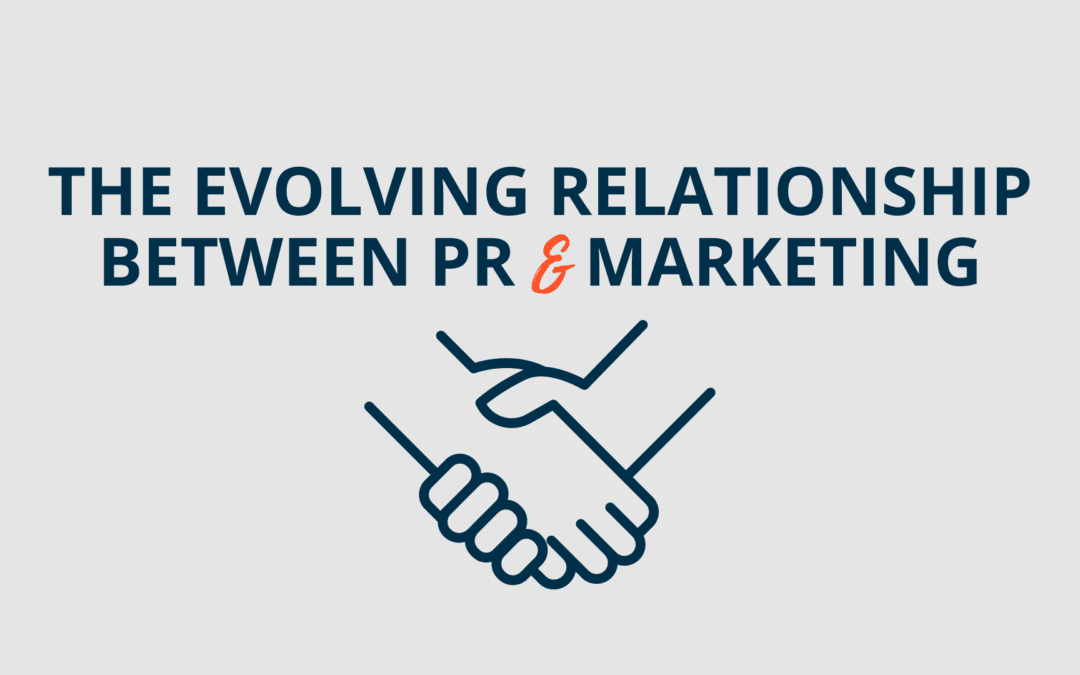Historically, PR and marketing departments in large companies have worked as distinct entities. PR has focused on communicating with the public and maintaining the company’s trust, reputation, and public perception. Marketing, on the other hand, has primarily focused on brand building, product promotion, and boosting sales.
In recent times, however, the line between public relations and marketing has blurred, with both entities now collaborating on a brand messaging front. According to research, 90% of PR professionals believe that marketing and PR will become more closely aligned over the next five years.
This doesn’t mean that PR and marketing will merge into one. However, PR professionals and marketers must re-evaluate the relationship between the two industries and work together towards shared goals.
In this article, we’ll take an in-depth look at how the relationship between PR and marketing has evolved and how the two departments can work together to develop and execute successful campaigns.
The alignment between PR and marketing
Despite their different focus areas, marketing and PR rely on effective brand communication to achieve their goals. In recent times, they are also reliant on the same channels to put out their communication—social media pages, websites, email, and so on. This has resulted in the unification of the two industries.
For instance, using your company’s social media pages to interact and engage with consumers can be seen as both a PR or marketing role. Such interactions help in ensuring your business reputation is in excellent standing and can, at the same time, help you attract customers and boost sales. This makes it difficult to draw a clear line between the two.
How PR and marketing can work together to drive success
Here are some ideas on how PR and marketing can collaborate for more effective campaigns:
Strengthening your brand presence
A strong brand presence is an asset from both a PR and marketing point of view. It also relies on good communication, which is one of the similarities between marketing and PR. Therefore, bringing your marketing and PR teams together can result in better brand collateral, such as brand colors, slogans and taglines, and audience approach. This, in turn, leads to a more robust and consistent brand presence.
For instance, let’s say you want to choose and register a domain name for your business. This is how the two departments would ideally work together. PR would help come up with a domain name that communicates the brand’s values, while marketing would give their insights to ensure the domain name makes sense from a marketing and SEO standpoint. Even though domain name registrations typically cost only $10 – $15 annually, choosing the right one can have a massive impact on your brand. Additionally, it’s a good idea to choose a provider that offers Free DNS, as it can make managing your domain easier and help improve your website’s performance without any extra cost.
Content amplification
Marketing teams excel at brand storytelling—putting together great stories that influence your target audience and can increase your sales. The problem is, such stories, however perfectly crafted, mean little if they don’t get to the right people. This is where PR professionals come in.
PR professionals have good relationships with influencers, journalists, and other media contacts. Working together, PR teams can leverage these relationships to maximize the reach of your marketing team’s content and create more impact from your marketing campaigns.
Similarly, marketing teams can use their skills to support PR teams. For instance, if the PR team is preparing a product launch announcement, marketing can step in with product videos, infographics, and other such content to support the announcement.
Unifying your brand message
The public relations department is usually tasked with creating a company’s brand values and messaging. Therefore, it’s a good idea for the marketing department to collaborate with PR when creating marketing content. The PR team can help the marketing team create content that’s more aligned with brand values and messaging and ensure that it maintains a consistent brand voice. Ultimately, this results in a strong and unified brand message.
Without such collaboration, it’s not surprising to see marketing teams creating content that isn’t aligned with brand values, which can dilute your brand message over time.
Improving your marketing strategy
When marketers are tasked with constantly marketing the same product, it gets to a point where it becomes challenging to come up with new, creative ideas. Hiring a marketing agency to bring in new ideas is an option, but it can be quite costly—the average cost for an independent digital marketing manager is over $68,000 per year.
By collaborating with PR, however, marketers can get insights from customer information gathered by PR, such as client feedback and testimonials. They can then use these insights to develop new marketing ideas and strategies. Additionally, collaboration with the PR team also creates opportunities for sharing more ideas.
Taking full advantage of earned media
Earned media is vital for any business that wants to thrive in today’s highly connected world. According to Communique PR, 92% of consumers trust earned media, compared to just 50% who trust paid ads. In other words, consumers trust what other people say about your brand more than what you say.
Historically, PR has been responsible for keeping track of earned media. However, it shouldn’t stop here. By sharing information gained from social listening and media monitoring, such as audience sentiment and mentions, with marketing teams, PR can give marketers insights into the impact of marketing campaigns on consumers. Marketers can then use this information to fine-tune marketing campaigns and achieve better success.
Improving PR communications
A lot of times, PR professionals focus on facts. When releasing announcements and press releases, PR teams usually share articles and media pitches full of data. The problem, however, is that people rarely remember data, so such announcements aren’t as effective as they should be.
Marketers, however, understand that data doesn’t move people. Consumers care more about stories than data. When marketers collaborate with PR professionals when creating media statements and press releases, they can weave in brand stories and create more memorable and impactful announcements.
For instance, let’s say your business just made new changes aimed at ensuring PCI compliance with customers. Typically, PR would simply make a statement to communicate these changes and leave it at that. However, by involving marketing, you can create a more impactful story around your decision to make the changes and what this means for your customers. By highlighting how being PCI compliant improves customer security and protects people’s sensitive data, you not only communicate the new changes but also get a chance to win new customers.
Wrapping up
Despite starting as independent industries, PR and marketing have gradually grown closer to a point where it’s becoming difficult to distinguish the roles of each. Fortunately, this blurring of the line between PR and marketing creates opportunities for businesses to redefine their relationship. It allows brands to develop strategies for the two to work together and create more impactful campaigns.
Integrating marketing and public relations can help brands strengthen their brand presence, amplify their content, unify the brand message, develop better marketing campaigns, take full advantage of earned media, and improve PR communications.








